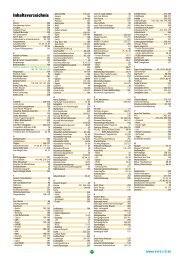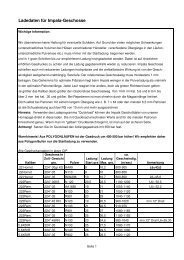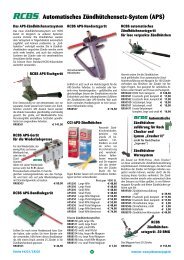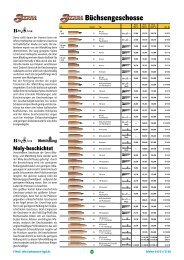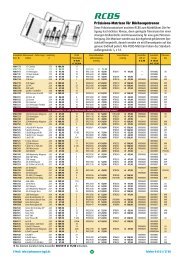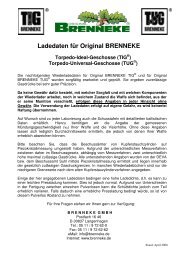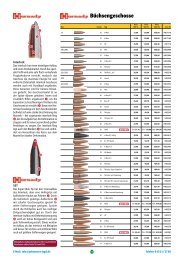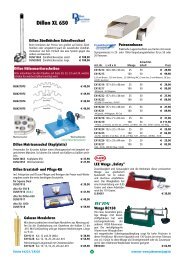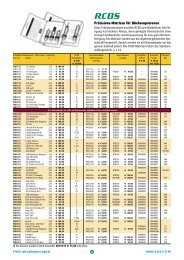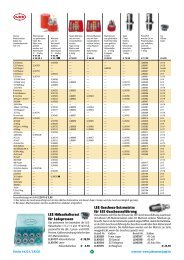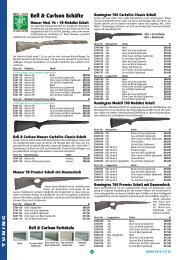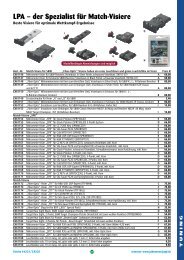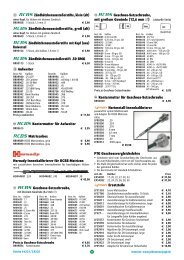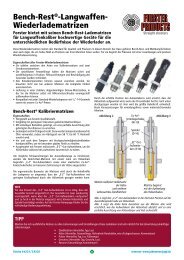instructions for using wilson inside neck reamers - LE WILSON Inc.
instructions for using wilson inside neck reamers - LE WILSON Inc.
instructions for using wilson inside neck reamers - LE WILSON Inc.
You also want an ePaper? Increase the reach of your titles
YUMPU automatically turns print PDFs into web optimized ePapers that Google loves.
L. E. Wilson <strong>Inc</strong>.<br />
PO Box 324<br />
404 Pioneer Ave<br />
Cashmere, WA 98815<br />
www.le<strong>wilson</strong>.com<br />
Phone : 509-782-1328<br />
Email: customerservice@le<strong>wilson</strong>.com Fax : 509-782-7200<br />
INSTRUCTIONS FOR USING <strong>WILSON</strong> INSIDE NECK REAMERS<br />
Inside Neck Reamers were designed <strong>for</strong> use in conjunction with the <strong>WILSON</strong> Case Trimmer, the trimmer acting as a jig <strong>for</strong> obtaining<br />
correct alignment between cartridge case and reamer and providing a substantial support during the reaming operation.<br />
First Time Set Up<br />
1. In use, the trimmer cutter is removed and the reamer inserted in its place.<br />
2. Bump the case lightly into the shell holder, the same as <strong>for</strong> trimming.<br />
3. If many cases are to be reamed, adjust the stop so that it will take the thrust of the reamer.<br />
4. With case in case holder, set on trimmer rails.<br />
5. While turning reamer, run cutting edge in and out of case mouth in one fluid motion.<br />
6. Repeat process<br />
These <strong>reamers</strong> are made from .002” to .003” larger than standard bullets in each caliber and if the case <strong>neck</strong>s have thickened so as to<br />
reduce the chamber clearance below that figure the reamer will remove the excess metal.<br />
What is achieved by <strong>using</strong> our <strong>reamers</strong>:<br />
If bullets are used that are larger than standard, the amount of <strong>neck</strong> clearance assured by these <strong>reamers</strong> will be reduced by the<br />
amount which these bullets exceed standard diameter.<br />
Here are three examples with different bullet diameters <strong>using</strong> the same reamer,<br />
1. .223” bullets Reamer measures .2265” the <strong>neck</strong> clearance will not be less than .0035”.<br />
2. .224” bullets Reamer measures .2265” the <strong>neck</strong> clearance will not be less than .0025”.<br />
3. .225” bullets Reamer measures .2265 the <strong>neck</strong> clearance will not be less than .0015”.<br />
The important point to remember is that the minimum <strong>neck</strong> clearance assured through the use of these <strong>reamers</strong> is the amount that the<br />
bullet you are <strong>using</strong> is smaller than the reamer used.<br />
NOTICE: These <strong>reamers</strong> will not assure that the <strong>neck</strong> clearance is not MORE than a certain amount. The <strong>reamers</strong> will remove metal,<br />
but will not put it on. They merely assure, <strong>for</strong> the sake of safety, that the <strong>neck</strong> clearance in the chamber is not <strong>LE</strong>SS than a certain<br />
amount.<br />
When to use our <strong>reamers</strong>:<br />
These <strong>reamers</strong> should be used on cases just as they come from the chamber, and then only if they have been fired with maximum<br />
loads or loads sufficiently heavy to fully expand the brass to chamber diameter. It is not advisable to use <strong>neck</strong> <strong>reamers</strong> on cases work<br />
hardened by repeated resizing to such an extent that they spring back after firing and don’t measure full chamber diameter or close to<br />
it. If used on cases not fully expanded, too much metal may be removed and bullets may not fit tightly in case <strong>neck</strong>s after resizing.<br />
There is no danger to the shooter in connection with <strong>using</strong> these <strong>reamers</strong> on resized cases or on cases fired with squib loads, but you<br />
could potentially ruin some very good brass in doing so.<br />
Our standard stock sizes of <strong>neck</strong> <strong>reamers</strong> are too large to use on cases as they come from the sizing die when making one caliber of<br />
case from another. Special sizes are required <strong>for</strong> these jobs and the price of specials is over that of standards.<br />
P<strong>LE</strong>ASE NOTE:<br />
The bearing portion of these <strong>reamers</strong> is purposely made short and ground slightly undersize to allow a slight universal joint effect.<br />
This permits the cutting end to align itself with the case mouth in spite of variations, which may be present in the cases themselves.<br />
It should be understood that these are not “line” <strong>reamers</strong>, that they are not designed <strong>for</strong> the purpose of correcting case <strong>neck</strong>s, which<br />
are thicker on one side than on the other. These <strong>reamers</strong> are centered and guided by the <strong>inside</strong> of the case <strong>neck</strong>. If the <strong>inside</strong> is not<br />
concentric with the outside, it will remain that way. They are primarily a safety item, having to do with clearance and not alignment.<br />
The fact that they contribute to accuracy by eliminating loads which otherwise would give excessive pressures is incidental to the main<br />
purpose.<br />
Line reaming of cartridge cases calls <strong>for</strong> much different and much more expensive and elaborate equipment, which we are not in a<br />
position to furnish at this time.
FEATURE ADDED TO THE <strong>WILSON</strong> INSIDE NECK REAMER<br />
(Not available on special Neck Reamers)<br />
A feature has been added to the Wilson Inside Neck Reamer so it can do an extra job <strong>for</strong> you. Many reloaders, especially bench rest<br />
shooters, have been reaming a short tapered section at the mouth of their resized cases after trimming and deburring. When they are<br />
ready <strong>for</strong> bullet seating, they insert the bullet by hand into the shallow taper which grips it firmly whether it has a boat tail, flat, cupped<br />
or any other shaped base. This prevents fumbling and dropping of bullets during handling, makes the seating start easier, and leaves<br />
a uni<strong>for</strong>m length of <strong>neck</strong> gripping each bullet. The taper need not be reamed again until trimming is once more needed.<br />
THE CUTTING PART OF THE <strong>WILSON</strong> INSIDE NECK REAMER HAS BEEN <strong>LE</strong>NGTHENED AND A SHORT TAPERED CUTTING<br />
SECTION HAS BEEN GROUND ON THE OUTER END TO DO THIS JOB.<br />
The reamer’s regular job of assuring adequate clearance between the <strong>neck</strong> of a loaded cartridge and the <strong>neck</strong> part of the chamber is<br />
still done exactly as be<strong>for</strong>e… on cases that have been fired with heavy enough loads to expand them to the full size of the rifle chamber.<br />
The reamer is run in about 9/16” until its shoulder stops against the <strong>neck</strong> of the case.<br />
This new job, however, must be done with care on cases at a later stage in the regular reloading procedure. Once set up it can be<br />
done quickly and it makes the bullet seating operation simpler and more accurate. Please read all the directions be<strong>for</strong>e <strong>using</strong> the new<br />
feature.<br />
To Use this Feature Follow These Steps:<br />
1. The case <strong>neck</strong> must be in the resized and <strong>neck</strong>-expanded condition to ream this short tapered section properly. The <strong>neck</strong><br />
expander normally will leave the <strong>inside</strong> diameter of the case <strong>neck</strong> .001 to .002” smaller than bullet diameter. If an unguided<br />
reamer is used, or if the case <strong>neck</strong> has not been expanded, it is possible to leave the case mouth so thin it would be sharp or at<br />
least so thin it could be easily damaged in use. With the Wilson reamer used on the resized and expanded case <strong>neck</strong>s, this cannot<br />
happen.<br />
2. Place the resized and <strong>neck</strong>-expanded case in the holder in the Wilson Case Trimmer as you would place a fired case <strong>for</strong> the<br />
regular <strong>neck</strong>-reaming job.<br />
3. Since this new tapered section on the <strong>neck</strong> reamer is on the end that enters the case <strong>neck</strong> first, adjust the trimmer stop screw so<br />
the <strong>neck</strong> reamer can enter the case only about 1/16” be<strong>for</strong>e the <strong>neck</strong> reamer handle stops against the trimmer bearing.<br />
4. Ream gently to the stop and remove the case. Inspect the case to see how deep you have reamed. If the mouth of the case<br />
shows more than about 1/16” of newly reamed section, the <strong>neck</strong> reamer is going in farther than necessary <strong>for</strong> this new job. To<br />
see if you have reamed deep enough, check by taking one of the bullets you will be <strong>using</strong> and pressing it into the newly reamed<br />
case <strong>neck</strong> with your fingers. It should stay in position even when shaken gently.<br />
**Since the base of the case is against a positive stop on one end and the <strong>neck</strong> reamer comes against a positive stop on the other,<br />
the length of the <strong>neck</strong> part gripping the seated bullet will be the same regardless of case length, another contribution toward<br />
uni<strong>for</strong>mity.<br />
**Please remember, do not run this reamer into a resized case up to the shoulder as you would on a fired case. It will remove too<br />
much brass and the <strong>neck</strong> will not grip the bullet at all.<br />
Stop Length<br />
Neck Reamer Shown In Case Trimmer<br />
Short Tapered Section<br />
Cutting Edge Bearing Surface Round Handle to Prevent<br />
Case De<strong>for</strong>mation when<br />
Reaming<br />
LIMITED WARRANTY<br />
All L.E. Wilson products are warranted against defective workmanship or materials under normal use <strong>for</strong> one year from the date of purchase. “Normal use” means as described in accompanying<br />
<strong>instructions</strong>. “Date of purchase” is <strong>for</strong> the first user of the product. The warranty applies only to the first user and does not cover consequential or incidental damages. If the user<br />
believes he has a defective tool he is asked to contact L.E. Wilson, <strong>Inc</strong>. P.O. Box 324 Cashmere, WA 98815 / 509-782-1328 describing the problem. The tool or part will be repaired or<br />
replaced at our option with no expense to the user except <strong>for</strong> correspondence costs. The part or tool must be accompanied by proof of purchase that shows source, date of purchase, and cost.<br />
All states have implied warranties created by law that apply to all consumers and most products so the above limitations and exclusions may not apply to you.



